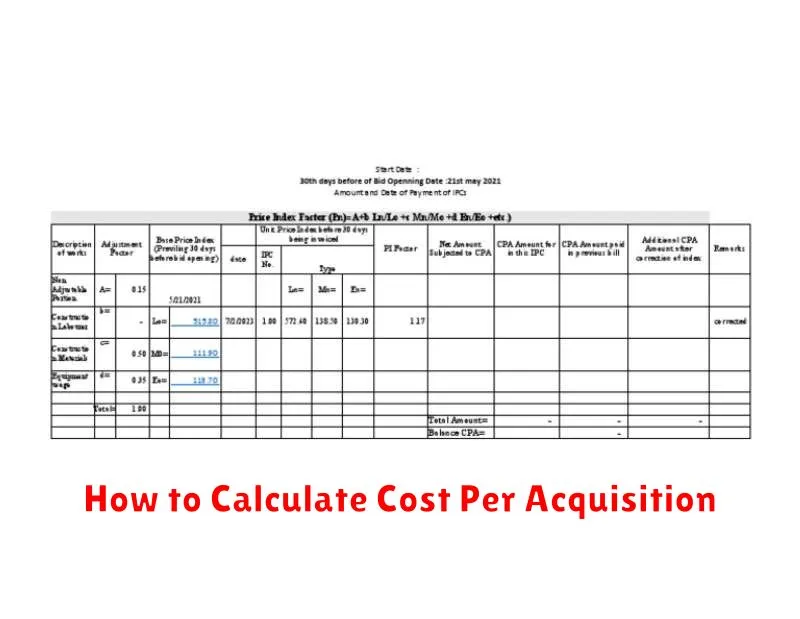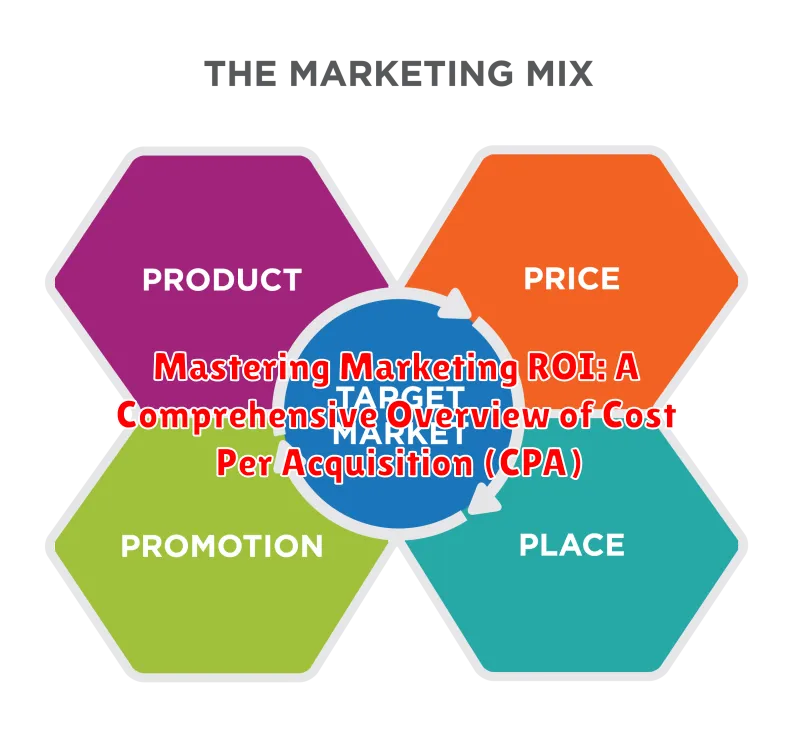Understanding and optimizing your marketing ROI is crucial for any business aiming for sustainable growth. One of the most vital metrics in achieving this understanding is Cost Per Acquisition (CPA). This comprehensive overview will delve into the intricacies of CPA, exploring its significance, calculation methods, and practical applications across various marketing channels. Mastering CPA empowers businesses to make informed decisions about their marketing investments, ensuring maximum efficiency and profitability in an increasingly competitive global landscape. This article serves as a guide to better decision making using data-driven strategies.
This exploration of Cost Per Acquisition goes beyond the basic definition. We will unpack how to accurately measure CPA, considering factors like campaign costs, attribution models, and the lifetime value of a customer. Furthermore, this article addresses strategies for reducing CPA while maintaining or even improving the quality of acquired customers. This includes optimizing ad campaigns, refining targeting strategies, and enhancing landing page conversion rates. By the end of this article, you will have a stronger understanding of how CPA plays a critical role in improving your overall marketing ROI.
What is Cost Per Acquisition (CPA)?
Cost Per Acquisition (CPA) is a pivotal marketing metric that measures the cost an advertiser incurs to acquire a single customer who completes a desired action. This action, often referred to as a conversion, can range from a purchase to a form submission or any other predefined goal.
Essentially, CPA provides a direct and quantifiable understanding of the efficiency of a marketing campaign. It reveals how much you are spending on average to convert a potential customer into an actual customer.
By closely monitoring CPA, marketers can determine which campaigns are the most effective and allocate their budgets accordingly. A lower CPA generally indicates a more efficient and successful campaign.
Why is CPA a Crucial Metric for Marketers?
Cost Per Acquisition (CPA) is a critical metric for marketers because it directly ties marketing spend to tangible results, specifically the cost of acquiring a new customer. This direct correlation enables marketers to:
- Measure ROI: CPA allows for precise calculation of return on investment for marketing campaigns. By understanding how much it costs to acquire a customer, marketers can determine if a campaign is profitable.
- Optimize Campaigns: Analyzing CPA data helps identify which channels and strategies are most effective. This allows marketers to allocate budget efficiently and improve overall campaign performance.
- Budget Effectively: With a clear understanding of CPA, marketers can accurately forecast acquisition costs and allocate marketing budgets more strategically.
- Improve Accountability: CPA provides a tangible metric that holds marketing teams accountable for their performance. It demonstrates the value of marketing efforts to stakeholders.
- Drive Business Growth: By focusing on lowering CPA, businesses can acquire more customers for the same budget, leading to accelerated growth.
How to Calculate Cost Per Acquisition

Calculating Cost Per Acquisition (CPA) is a straightforward process. It involves dividing the total cost of a marketing campaign by the number of acquisitions achieved.
The formula is as follows:
CPA = Total Marketing Spend / Number of Acquisitions
For example, if a company spends $5,000 on a Google Ads campaign and acquires 50 new customers, the CPA would be $100.
Example:
- Total Ad Spend: $5,000
- New Customers Acquired: 50
- CPA: $5,000 / 50 = $100
This calculation provides a clear understanding of how much it costs to acquire a single customer through a specific marketing effort.
Factors Influencing Your Cost Per Acquisition
Several key factors can significantly influence your Cost Per Acquisition (CPA). Understanding these elements is crucial for optimizing your marketing campaigns and achieving a desirable ROI.
- Ad Quality and Relevance: Higher quality ads that are relevant to the target audience generally lead to better click-through rates and conversion rates, thereby lowering CPA.
- Targeting Accuracy: Precise targeting ensures that your ads are shown to individuals most likely to convert. Broad targeting often results in wasted ad spend and higher CPA.
- Bidding Strategy: Your bidding strategy plays a vital role. Aggressive bidding might increase visibility but also raises costs, while a conservative approach might limit reach but could offer better CPA.
- Landing Page Optimization: A poorly designed or irrelevant landing page can deter conversions, even if the initial ad is effective. Optimizing for user experience and relevance is paramount.
- Seasonality and Market Trends: External factors like seasonal demand and market trends can impact ad costs and conversion rates, affecting CPA.
- Competition: Increased competition for the same target audience typically drives up ad costs, leading to a higher CPA.
CPA vs. Other Marketing Metrics: Which Ones Matter?
While Cost Per Acquisition (CPA) provides a direct measure of customer acquisition efficiency, it’s essential to understand its relationship with other key marketing metrics. Focusing solely on CPA without considering these interconnected metrics can lead to a skewed understanding of overall campaign performance.
Here’s a look at some important metrics to consider alongside CPA:
- Customer Lifetime Value (CLTV): Understanding the long-term value of a customer acquired through a specific campaign is critical. A higher CPA might be acceptable if CLTV is significantly high.
- Return on Ad Spend (ROAS): ROAS measures the revenue generated for every dollar spent on advertising. It provides a broader view of campaign profitability.
- Conversion Rate: This metric reflects the percentage of users who complete a desired action (e.g., purchase, sign-up). Optimizing conversion rates can directly impact CPA.
- Click-Through Rate (CTR): CTR indicates the effectiveness of your ad copy and targeting. Higher CTR can lead to lower CPA.
In conclusion, while CPA is a valuable metric, a holistic approach that considers CLTV, ROAS, conversion rates, and CTR offers a more comprehensive understanding of marketing effectiveness and enables data-driven optimization strategies.
Strategies for Lowering Your Cost Per Acquisition
Optimizing your Cost Per Acquisition (CPA) is essential for maximizing marketing Return on Investment (ROI). Several strategies can be implemented to achieve this goal.
Refine Your Targeting
Ensure your campaigns are reaching the most relevant audience. Use demographic, interest, and behavioral data to narrow your focus and eliminate wasted ad spend.
Improve Ad Relevance and Quality Score
A higher Quality Score results in lower costs and better ad positioning. Focus on creating compelling ad copy that matches user intent and links to relevant landing pages.
Optimize Landing Page Conversion Rates
A well-designed and optimized landing page can significantly impact your CPA. Ensure your landing page is user-friendly, has a clear call-to-action, and provides valuable information that addresses the user’s needs.
A/B Test Your Ads and Landing Pages
Continuously test different ad creatives, headlines, and landing page elements to identify what resonates best with your target audience. Use A/B testing to optimize for higher conversion rates and lower CPA.
Tools for Tracking and Managing CPA
Effective CPA management hinges on the utilization of appropriate tools for tracking and analysis. These tools provide valuable insights into campaign performance, allowing marketers to optimize their strategies and reduce acquisition costs.
Analytics Platforms
Platforms like Google Analytics and Adobe Analytics are fundamental for tracking website traffic, conversions, and user behavior. They provide data on which channels are driving the most valuable customers.
Advertising Platform Dashboards
Google Ads, Facebook Ads Manager, and other advertising platforms offer built-in dashboards that provide real-time data on campaign performance, including CPA, click-through rates, and conversion rates.
Marketing Automation Software
Tools such as HubSpot and Marketo can help automate marketing tasks and track the customer journey from initial contact to conversion, providing a comprehensive view of CPA across various touchpoints.
Attribution Modeling Tools
These tools, like Mixpanel, help attribute conversions to specific marketing activities, allowing marketers to understand which campaigns are most effective in driving acquisitions. They are crucial for getting an accurate view of your CPA.
Understanding CPA Benchmarks by Industry

Cost Per Acquisition (CPA) benchmarks vary significantly across different industries. Understanding these variations is crucial for setting realistic marketing goals and evaluating campaign performance.
For example, industries with high-value products or services, such as insurance or legal services, often have higher CPAs than industries selling low-cost consumer goods.
Factors contributing to these differences include:
- Customer Lifetime Value (CLTV): Industries with higher CLTV can afford higher CPAs.
- Competition: More competitive industries typically have higher advertising costs, leading to higher CPAs.
- Target Audience: The complexity of reaching the target audience can influence CPA.
While specific numbers fluctuate, researching industry-specific reports and data is essential for gaining insights into relevant CPA benchmarks. Comparing your CPA against these benchmarks provides a valuable context for assessing your marketing efficiency and identifying areas for improvement. Keep in mind these are benchmarks and your specific business model and market position will influence what a “good” CPA looks like for you.
The Impact of Targeting on Cost Per Acquisition
Targeting plays a pivotal role in determining your Cost Per Acquisition (CPA). Precise targeting ensures that your marketing efforts reach the most receptive audience, minimizing wasted ad spend and increasing conversion rates.
Poor targeting, on the other hand, can lead to higher CPAs as ads are shown to individuals who are unlikely to convert. This results in a lower ROI and inefficient use of marketing resources.
Consider the following factors when optimizing your targeting strategy:
- Demographics: Age, gender, location, income, education.
- Interests: Hobbies, passions, online behavior.
- Behavior: Purchase history, website activity, app usage.
- Custom Audiences: Uploaded lists of existing customers or prospects.
- Lookalike Audiences: Identify new audiences similar to your best customers.
By refining your targeting based on data-driven insights, you can significantly improve your CPA and overall marketing efficiency.
Optimizing Landing Pages for Lower CPA
Your landing page is the final step in converting a potential customer. Optimizing it is critical to lowering your Cost Per Acquisition (CPA). A poorly designed landing page can negate the effectiveness of even the best-targeted ad campaigns.
Here are key areas to focus on:
- Clear Headline and Value Proposition: Immediately communicate what the visitor will gain.
- Compelling Call-to-Action (CTA): Make it obvious what action you want the visitor to take (e.g., “Sign Up Now,” “Get a Free Quote”).
- Mobile Optimization: Ensure your landing page is responsive and functions seamlessly on all devices.
- Page Load Speed: A slow loading page can lead to high bounce rates. Optimize images and code for faster loading times.
- A/B Testing: Continuously test different elements (headlines, CTAs, images) to see what performs best.
By focusing on these areas, you can improve conversion rates and ultimately reduce your CPA.

